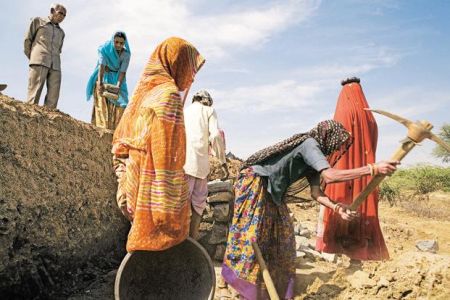On 1 February, The Finance Minister of India presented the Union Budget 2017-18. In this article, Yamini Aiyar, Director of Accountability Initiative, contends that for social policy, the Budget suggests more continuity than radical change in India’s welfare architecture. However, it lacks a coherent vision for health and education.
There were no surprises - no helicopter drop of money into Jan-Dhan1accounts; no move to dismantle ongoing welfare schemes in favour of a universal basic income (UBI). Far from being the populist, game-changing Budget that many had expected, Union Finance Minister Arun Jaitley presented a sombre, status quo budget which, apart from some tinkering with allocations, offers no vision or agenda for social policy, especially when it comes to core sectors like health and education.
Most key social sector ministries saw some increases in allocation (see Table 2). The Mahatma Gandhi National Rural Employment Guarantee Act (MNREGA)2is an interesting story. In his budget speech, the Finance Minister made it a point to highlight that the MNREGA has received its highest allocation ever at Rs. 480 billion. However, this is a mere 1% increase from the allocation in 2016-17 which, when we include supplementary budgets made through the year, stood at Rs. 474.99 billion (revised estimate). Moreover, expenditure for 2016-17 (as on 1 February) is Rs. 535.94 billion. This suggests that even the “highest ever allocation” is nowhere near what the scheme really needs if demand for work is to be met.
Table 1. Social-sector allocations (Rs. billion)
| Scheme | 2016-17 RE | 2017-18 BE | Increase |
| Sarva Shiksha Abhiyan (SSA) | 225 | 235 | 4% |
| Integrated Child Development Services (ICDS) (core) | 145.61 | 152.45 | 5% |
| Mid Day Meals | 97 | 100 | 3% |
| Swacch Bharat – Urban (SBM-U) | 23 | 23 | 0% |
| Swachh Bharat – Rural (SBM-G) | 105 | 139.48 | 33% |
| MNREGA | 474.99 | 480 | 1% |
| National Health Mission (NHM) | 221.98 | 266.91 | 20% |
| Pradhan Mantri Gram Sadak Yojana (PMGSY) | 190 | 190 | 0% |
| Pradhan Mantri Awas Yojana -Urban | 49.36 | 60.43 | 22% |
| Pradhan Mantri Awas Yojana -Rural | 160 | 230 | 44% |
| LPG subsidy | 186.78 | 160.76 | -14% |
| National Social Assistance Programme (NSAP) | 95 | 95 | 0% |
| Maternity Benefit Programme | 6.34 | 27 | 326% |
| National Health Protection Scheme | 7.24 | 10 | 38% |
Table 2. Key ministry allocations (Rs. billion)
| Ministries | 2015-16 Actuals | 2016-17 BE | 2016-17 RE | 2017-18BE | % increase between 2016-17 RE and 2017-18 BE | % increase between 2016-17 BE and 2017-18 BE |
| Ministry of Human Resource Development (MHRD) | 672.39 | 723.94 | 735.99 | 796.86 | 8.27% | 10.07% |
| Ministry of Rural Development (MoRD) | 789.44 | 877.65 | 977.60 | 1077.58 | 10.23% | 22.78% |
| Ministry of Health and Family Welfare (MHFW) | 341.14 | 382.06 | 396.88 | 488.52 | 23.09% | 27.86% |
| Ministry of Urban Development (MoUD) | 184.19 | 245.23 | 325.49 | 342.11 | 5.11% | 39.51% |
| Ministry of Drinking Water and Sanitation (MDWS) | 110.81 | 140.09 | 165.11 | 200.10 | 21.19% | 42.84% |
| Ministry of Women and Child Development (MWCD) | 172.48 | 174.08 | 176.40 | 220.94 | 25.25% | 26.92% |
BE=Budget estimates, RE=Revised estimates
Source: Union Budget, Expenditure Budget Volume 2
The Finance Minister’s status quo approach to social policy should lay to rest, for the moment at least, the ongoing debate about this government’s attempt to radically restructure India’s welfare architecture. Even though the conversation on a UBI has gained ground, especially with a chapter in the Economic Survey 2016-17, this budget seems to indicate the government’s increased reliance on the United Progressive Alliance’s (UPA) rights-based welfare regime rather than anything new.
This is best evidenced in the fact that the Finance Minister dedicated three long paragraphs in his speech to fairly minor implementation details of the MNREGA.
But these three paragraphs also highlight the greatest weakness in the current approach to social policy. It is no secret that most current social sector schemes, and particularly the MNREGA, suffer from serious implementation failures. The roots of these failures lie in weak State capacity. But rather than building an administrative reforms agenda that could address these failures across schemes, Jaitley chose to do the job of a Gram Panchayat (village council) president, announcing the list of assets that will be created through MNREGA.
The only big reform in the MNREGA was the announcement of geotagging assets created. Considering that most workers are yet to receive their MNREGA payments on time - in 2016-17, till 13 January, 53% of payments, amounting to Rs. 127.06 billion, were delayed - it is unclear why geotagging assets should be the focus of the budget speech.
Like every year, the budget offers little on health and education. The National Health Mission has been given a 20% increase. But apart from a commitment to reducing infant and maternal mortality, the budget speech offers little by way of the government’s policy vision to deal with the vexed problems of poor-quality healthcare in India.
In fact, the Finance Minister commits to converting 150,000 sub-centres into wellness centres but how he intends to do this given the high rates of vacancies and absenteeism is anybody’s guess.
The Sarva Shiksha Abhiyan (SSA), the government’s flagship programme for elementary education, saw no change in allocation. The speech announced the launch of an annual assessment for learning outcomes. This process has been under way for some time and is certainly welcome but the real issue of how this measurement of outcomes is going to be used remains unanswered.
There is one interesting announcement on rural development programmes that merits discussion: Mission Antyodaya is an attempt to converge rural development schemes in 50,000 gram panchayats and link implementation to a panchayat-level micro plan for sustainable livelihood. Progress will be measured on the basis of a poverty index developed using Socio-economic Caste Census data at the panchayat level. This is a welcome move.
At present, most rural development schemes are implemented through multiple parallel bodies with different financing and planning mechanisms, which make responding to local needs impossible.
So, if a panchayat has a greater need for funds for drinking water rather than roads, it doesn’t have the power to reallocate resources as scheme goals and targets are set at the state and central government levels.
However, implementing this convergence model is a real challenge. For one it will require departments to work in collaboration with each other. To explain, if a panchayat wants to use MNREGA funds for irrigation then both the MNREGA and agriculture department officials will have to work collaboratively. This collaborative approach is the antithesis of the current silo-based institutional culture of the bureaucracy and too often good ideas have failed precisely because convergence of departments and officials doesn’t occur in practice. To get this right, the Ministry of Rural Development will have to focus on changing the administrative culture on the ground. Importantly, this will require a greater effort at devolving finances to gram panchayats and making them genuinely in charge of delivering local services. And on decentralisation to panchayats, apart from one reference to improvements in human resources, the budget is silent.
Finally, this budget has been remarkably silent on the move to restructure the financing architecture for social policy post the 14th Finance Commission. In fact, the emphasis on schemes suggests that rather than using the opportunity to reorient the role of the Centre in social-sector financing, we are back to the old one-size-fits-all approach of Central schemes. And by maintaining this status quo, this budget is a real opportunity lost.
This article originally appeared in Mint: http://www.livemint.com/Opinion/dJPQ7k3QEuLsBV2iLbWv5L/A-status-quo-budget-for-the-social-sector.html.
Notes:
- Pradhan Mantri Jan dhan Yojana (PMJDY) is the Indian government’s flagship financial inclusion scheme. It envisages universal access to banking facilities with at least one basic banking account for every household; financial literacy, access to credit insurance and pension facility.
- The Mahatma Gandhi National Rural Employment Guarantee Act (MNREGA), 2006 guarantees 100 days of employment in a financial year to every rural household whose adult members are willing to do unskilled manual work at the minimum wage.




 03 February, 2017
03 February, 2017 





Comments will be held for moderation. Your contact information will not be made public.